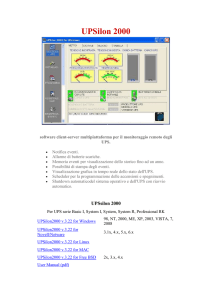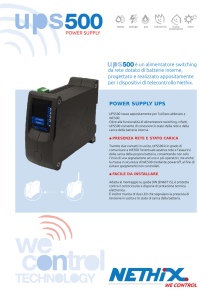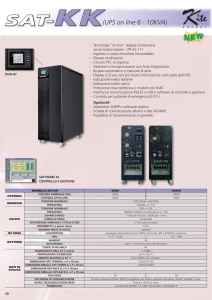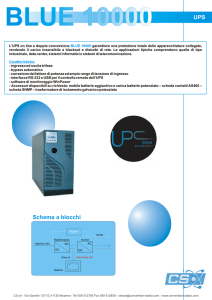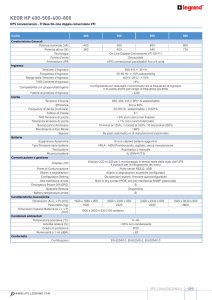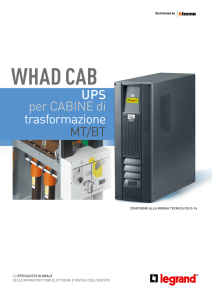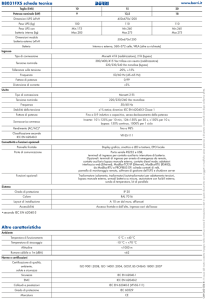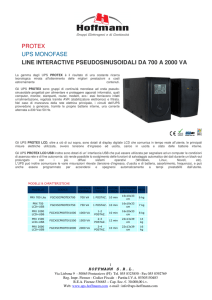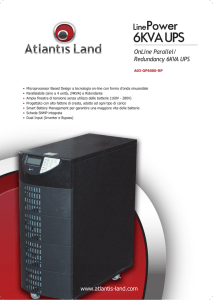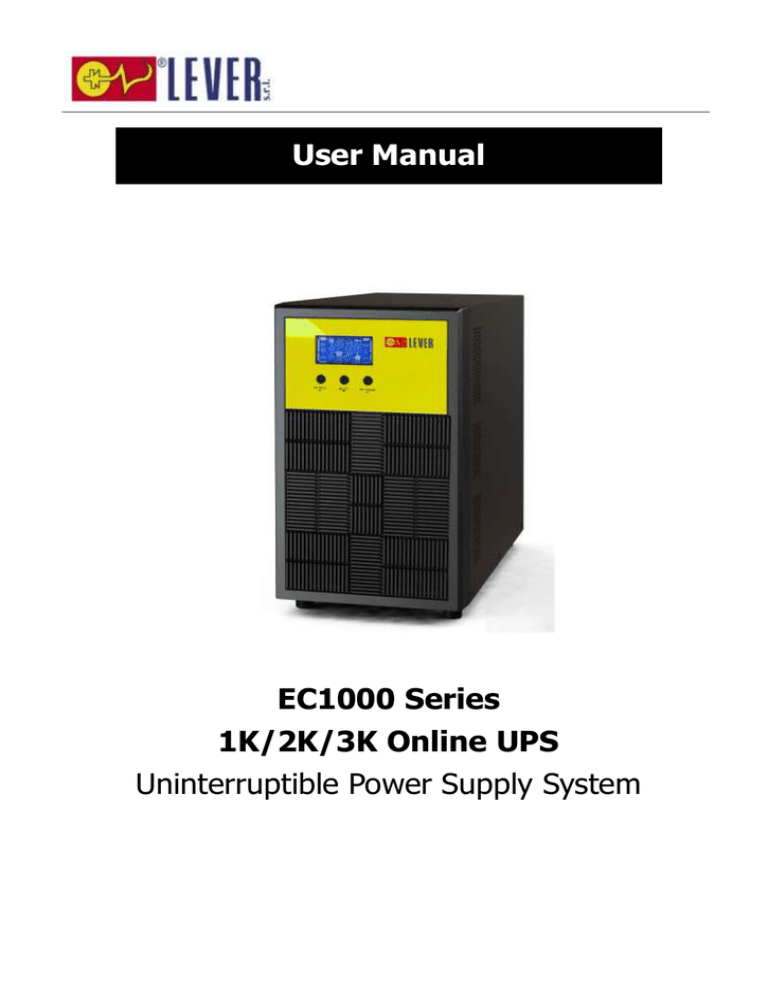
User Manual
EC1000 Series
1K/2K/3K Online UPS
Uninterruptible Power Supply System
Table of Contents
1. Important Safety Warning ................................................................................... 2
1-1. Transportation ........................................................................................................................... 2
1-2. Preparation ................................................................................................................................ 2
1-3. Installation ................................................................................................................................ 2
1-4. Operation .................................................................................................................................. 2
1-5. Maintenance, service and faults................................................................................................ 3
2. Installation and setup .......................................................................................... 3
2-1. Rear panel view ........................................................................................................................ 3
2-2. Setup the UPS ........................................................................................................................... 5
3. Operations ............................................................................................................ 7
3-1. Button operation ....................................................................................................................... 7
3-2. LCD Panel ................................................................................................................................ 8
3-3. Audible Alarm........................................................................................................................... 9
3-4. LCD display wordings index .................................................................................................... 9
3-5. UPS Setting............................................................................................................................. 10
3-6. Operating Mode Description .................................................................................................. 13
3-7. Faults Reference Code ............................................................................................................ 14
3-8. Warning indicator ................................................................................................................... 14
4. Troubleshooting.................................................................................................. 15
5. Storage and Maintenance ................................................................................... 16
6. Specifications ..................................................................................................... 17
1
1. Important Safety Warning
Please comply with all warnings and operating instructions in this manual strictly. Save this
manual properly and read carefully the following instructions before installing the unit. Do not
operate this unit before reading through all safety information and operating instructions
carefully
1-1. Transportation
Please transport the UPS system only in the original package to protect against shock
and impact.
1-2. Preparation
Condensation may occur if the UPS system is moved directly from cold to warm
environment. The UPS system must be absolutely dry before being installed. Please
allow at least two hours for the UPS system to acclimate the environment.
Do not install the UPS system near water or in moist environments.
Do not install the UPS system where it would be exposed to direct sunlight or near
heater.
Do not block ventilation holes in the UPS housing.
1-3. Installation
Do not connect appliances or devices which would overload the UPS system (e.g.
laser printers) to the UPS output sockets.
Place cables in such a way that no one can step on or trip over them.
Do not connect domestic appliances such as hair dryers to UPS output sockets.
The UPS can be operated by any individuals with no previous experience.
Connect the UPS system only to an earthed shockproof outlet which must be easily
accessible and close to the UPS system.
Please use only VDE-tested, CE-marked mains cable (e.g. the mains cable of your
computer) to connect the UPS system to the building wiring outlet (shockproof
outlet).
Please use only VDE-tested, CE-marked power cables to connect the loads to the UPS
system.
When installing the equipment, it should ensure that the sum of the leakage current
of the UPS and the connected devices does not exceed 3.5mA.
1-4. Operation
Do not disconnect the mains cable on the UPS system or the building wiring outlet
(shockproof socket outlet) during operations since this would cancel the protective
earthing of the UPS system and of all connected loads.
The UPS system features its own, internal current source (batteries). The UPS output
sockets or output terminals block may be electrically live even if the UPS system is not
connected to the building wiring outlet.
In order to fully disconnect the UPS system, first press the OFF/Enter button to
disconnect the mains.
Prevent no fluids or other foreign objects from inside of the UPS system.
2
1-5. Maintenance, service and faults
The UPS system operates with hazardous voltages. Repairs may be carried out only
by qualified maintenance personnel.
Caution - risk of electric shock. Even after the unit is disconnected from the mains
(building wiring outlet), components inside the UPS system are still connected to the
battery and electrically live and dangerous.
Before carrying out any kind of service and/or maintenance, disconnect the batteries
and verify that no current is present and no hazardous voltage exists in the terminals
of high capability capacitor such as BUS-capacitors.
Only persons are adequately familiar with batteries and with the required
precautionary measures may replace batteries and supervise operations.
Unauthorized persons must be kept well away from the batteries.
Caution - risk of electric shock. The battery circuit is not isolated from the input
voltage. Hazardous voltages may occur between the battery terminals and the
ground. Before touching, please verify that no voltage is present!
Batteries may cause electric shock and have a high short-circuit current. Please take
the precautionary measures specified below and any other measures necessary when
working with batteries:
-remove wristwatches, rings and other metal objects
-use only tools with insulated grips and handles.
When changing batteries, install the same number and same type of batteries.
Do not attempt to dispose of batteries by burning them. This could cause battery
explosion.
Do not open or destroy batteries. Escaping electrolyte can cause injury to the skin
and eyes. It may be toxic.
Please replace the fuse only with the same type and amperage in order to avoid fire
hazards.
Do not dismantle the UPS system.
2. Installation and setup
NOTE: Before installation, please inspect the unit. Be sure that nothing inside the package is
damaged. Please keep the original package in a safe place for future use.
NOTE: There are two different types of online UPS: standard and long-run models. Please
refer to the following model table.
Model
1K
2K
3K
Type
Model
1K-SC
2K-SC
3K-SC
Standard
2-1. Rear panel view
1K(L) TOWER
3
Type
Long-run
IEC Type
Schuko Type
India Type
Africa Type
NEMA Type
Africa Type
NEMA Type
AU Type
2K(L) TOWER
IEC Type
Schuko Type
India Type
Schuko Type
India Type
AU Type
3K(L) TOWER
IEC Type
1.
2.
3.
4.
5.
6.
7.
Africa Type
Programmable outlets: connect to non-critical loads.
Output receptacles: connect to mission-critical loads.
AC input
Input circuit breaker
Network/Fax/Modem surge protection
Emergency power off function connector (EPO)
USB communication port
8. RS-232 communication port
9. SNMP intelligent slot
10. External battery connection (only available for L model)
11. Output terminal
12. Output circuit breaker
13. Input terminal
4
NEMA Type
AU Type
2-2. Setup the UPS
Step 1: UPS input connection
Plug the UPS into a two-pole, three-wire, grounded receptacle only. Avoid using extension
cords.
For 200/208/220/230/240VAC models: The power cord is supplied in the UPS package.
For 100/110/115/120/127VAC models: The power cord is attached to the UPS. The input
plug is a NEMA 5-15P for 1K, 1K-SC models, NEMA 5-20P for 2K and 2K-SC models.
Note: For Low voltage models: Check if the site wiring fault indicator lights up in LCD panel. It
will be illuminated when the UPS is plugged into an improperly wired utility power outlet (Refer
to Troubleshooting section). Please also install a circuit breaker (40A) between the mains and
AC input in 3K model for safety operation.
Step 2: UPS output connection
For socket-type outputs, there two kinds of outputs: programmable outlets and general
outlets. Please connect non-critical devices to the programmable outlets and critical
devices to the general outlets. During power failure, you may extend the backup time to
critical devices by setting shorter backup time for non-critical devices.
For terminal-type input or outputs, please follow below steps for the wiring configuration:
a) Remove the small cover of the terminal block
b) Suggest using AWG14 or 2.1mm2 power cords. Suggest using AWG12-10 or
3.3mm2-5.3mm2 power cords for NEMA type.
c) Upon completion of the wiring configuration, please check whether the wires are
securely affixed.
d) Put the small cover back to the rear panel.
Step 3: Communication connection
Communication port:
USB port
RS-232 port
Intelligent slot
To allow for unattended UPS shutdown/start-up and status monitoring, connect the
communication cable one end to the USB/RS-232 port and the other to the communication
port of your PC. With the monitoring software installed, you can schedule UPS
shutdown/start-up and monitor UPS status through PC.
The UPS is equipped with intelligent slot perfect for either SNMP or AS400 card. When
installing either SNMP or AS400 card in the UPS, it will provide advanced communication and
monitoring options.
PS. USB port and RS-232 port can’t work at the same time.
Step 4: Network connection
Network/Fax/Phone surge port
Connect a single modem/phone/fax line into surge-protected “IN” outlet on the back panel of
the UPS unit. Connect from “OUT” outlet to the equipment with another modem/fax/phone line
cable.
5
Step 5: Disable and enable EPO function
Keep the pin 1 and pin 2 closed for UPS normal operation. To activate EPO function, cut the
wire between pin 1 and pin 2.
It’s in closed status for UPS
normal operation.
Step 6: Turn on the UPS
Press the ON/Mute button on the front panel for two seconds to power on the UPS.
Note: The battery charges fully during the first five hours of normal operation. Do not
expect full battery run capability during this initial charge period.
Step 7: Install software
For optimal computer system protection, install UPS monitoring software to fully configure UPS
shutdown. You may insert provided CD into CD-ROM to install the monitoring software. If not,
please follow steps below to download and install monitoring software from the internet:
1. Go to the website http://www.power-software-download.com
2. Click ViewPower software icon and then choose your required OS to download the software.
3. Follow the on-screen instructions to install the software.
4. When your computer restarts, the monitoring software will appear as an orange plug icon
located in the system tray, near the clock.
Step 8: External battery connection (for long-run models only)
Follow the right chart to make external
battery connection.
6
3. Operations
3-1. Button operation
Button
Function
Turn on the UPS: Press and hold ON/Mute button for at least 2
seconds to turn on the UPS.
Mute the alarm: When the UPS is on battery mode, press and hold
this button for at least 5 seconds to disable or enable the alarm
system. But it’s not applied to the situations when warnings or errors
ON/Mute Button
occur.
Up key: Press this button to display previous selection in UPS setting
mode.
Switch to UPS self-test mode: Press and hold ON/Mute button for 5
seconds to enter UPS self-testing while in AC mode, ECO mode, or
converter mode.
Turn off the UPS: Press and hold this button at least 2 seconds to turn
off the UPS. UPS will be in standby mode under power normal or
transfer to Bypass mode if the Bypass enable setting by pressing this
OFF/Enter Button
button.
Confirm selection key: Press this button to confirm selection in UPS
setting mode.
Switch LCD message: Press this button to change the LCD message
for input voltage, input frequency, battery voltage, output voltage
and output frequency. It will return back to default display when
pausing for 10 seconds.
Select Button
Setting mode: Press and hold this button for 5 seconds to enter UPS
setting mode when UPS is in standby mode or bypass mode.
Down key: Press this button to display next selection in UPS setting
mode.
Switch to bypass mode: When the main power is normal, press
ON/Mute + Select
ON/Mute and Select buttons simultaneously for 5 seconds. Then UPS
Button
will enter to bypass mode. This action will be ineffective when the
input voltage is out of acceptable range.
7
3-2. LCD Panel
Display
Function
Remaining backup time information
Indicates the remaining backup time in pie chart.
Indicates the remaining backup time in numbers.
H: hours, M: minute, S: second
Fault information
Indicates that the warning and fault occurs.
Indicates the warning and fault codes, and the codes are listed in
details in 3-5 section.
Mute operation
Indicates that the UPS alarm is disabled.
Output & Battery voltage information
Indicates the output voltage, frequency or battery voltage.
Vac: output voltage, Vdc: battery voltage, Hz: frequency
Load information
Indicates the load level by 0-25%, 26-50%, 51-75%, and
76-100%.
Indicates overload.
Indicates the load or the UPS output is short circuit.
Programmable outlets information
Indicates that programmable management outlets are working.
Mode operation information
Indicates the UPS connects to the mains.
8
Indicates the battery is working.
Indicates the bypass circuit is working.
Indicates the ECO mode is enabled.
Indicates the Inverter circuit is working.
Indicates the output is working.
Battery information
Indicates the Battery level by 0-25%, 26-50%, 51-75%, and
76-100%.
Indicates the battery is fault.
Indicates low battery level and low battery voltage.
Input & Battery voltage information
Indicates the input voltage or frequency or battery voltage.
Vac: Input voltage, Vdc: battery voltage, Hz: input frequency
3-3. Audible Alarm
Battery Mode
Low Battery
Overload
Fault
Bypass Mode
Sounding every 4 seconds
Sounding every second
Sounding twice every second
Continuously sounding
Sounding every 10 seconds
3-4. LCD display wordings index
Abbreviation
Display content
Meaning
ENA
Enable
DIS
Disable
ESC
Escape
HLS
High loss
LLS
Low loss
BAT
Battery
CF
Converter
EP
EPO
TP
Temperature
CH
Charger
9
FU
Bypass frequency unstable
EE
EEPROM error
3-5. UPS Setting
There are three parameters to set up the
UPS.
Parameter 1
Parameter 1: It’s for program
alternatives. There are 10 programs to set
up. Refer to below table.
Parameter 2 and parameter 3 are the
setting options or values for each
program.
Parameter 2
Parameter 3
01: Output voltage setting
Interface
Setting
Parameter 3: Output voltage
For 200/208/220/230/240 VAC models, you may choose
the following output voltage:
200: presents output voltage is 200Vac
208: presents output voltage is 208Vac
220: presents output voltage is 220Vac
230: presents output voltage is 230Vac (Default)
240: presents output voltage is 240Vac
For 100/110/150/120/127 VAC models, you may choose
the following output voltage:
100: presents output voltage is 100Vac
110: presents output voltage is 110Vac
115: presents output voltage is 115Vac
120: presents output voltage is 120Vac (Default)
127: presents output voltage is 127Vac
02: Frequency Converter enable/disable
Interface
Setting
Parameter 2 & 3: Enable or disable converter mode. You
may choose the following two options:
CF ENA: converter mode enable
CF DIS: converter mode disable (Default)
10
03: Output frequency setting
Interface
Setting
Parameter 2 & 3: Output frequency setting.
You may set the initial frequency on battery mode:
BAT 50: presents output frequency is 50Hz
BAT 60: presents output frequency is 60Hz
If converter mode is enabled, you may choose the
following output frequency:
CF 50: presents output frequency is 50Hz
CF 60: presents output frequency is 60Hz
04: ECO enable/disable
Interface
Setting
Parameter 3: Enable or disable ECO function. You may
choose the following two options:
ENA: ECO mode enable
DIS: ECO mode disable (Default)
05: ECO voltage range setting
Interface
Setting
Parameter 2 & 3: Set the acceptable high voltage point
and low voltage point for ECO mode by pressing Down key
or Up key.
HLS: High loss voltage in ECO mode in parameter 2.
For 200/208/220/230/240 VAC models, the setting range
in parameter 3 is from +7V to +24V of the nominal voltage.
(Default: +12V)
For 100/110/115/120/127 VAC models, the setting range
in parameter 3 is from +3V to +12V of the nominal voltage.
(Default: +6V)
LLS: Low loss voltage in ECO mode in parameter 2.
For 200/208/220/230/240 VAC models, the setting range
in parameter 3 is from -7V to -24V of the nominal voltage.
(Default: -12V)
For 100/110/115/120/127 VAC models, the setting voltage
in parameter 3 is from -3V to -12V of the nominal voltage.
(Default: -6V)
06: Bypass enable/disable when UPS is off
Interface
Setting
Parameter 3: Enable or disable Bypass function. You may
choose the following two options:
ENA: Bypass enable
DIS: Bypass disable (Default)
11
07: Bypass voltage range setting
Interface
Setting
Parameter 2 & 3: Set the acceptable high voltage point
and acceptable low voltage point for Bypass mode by
pressing the Down key or Up key.
HLS: Bypass high voltage point
For 200/208/220/230/240 VAC models:
230-264: setting the high voltage point in parameter 3
from 230Vac to 264Vac. (Default: 264Vac)
For 100/110/115/120/127 VAC models:
120-140: setting the high voltage point in parameter 3
from 120Vac to 140Vac(Default: 132Vac)
LLS: Bypass low voltage point
For 200/208/220/230/240 VAC models:
170-220: setting the low voltage point in parameter 3
from 170Vac to 220Vac (Default: 170Vac)
For 100/110/115/120/127 VAC models:
85-115: setting the low voltage point in parameter 3 from
85Vac to 115Vac. (Default: 85Vac)
08: Programmable outlets enable/disable
Interface
Setting
Parameter 3: Enable or disable programmable outlets.
ENA: Programmable outlets enable
DIS: Programmable outlets disable (Default)
09: Programmable outlets setting
Interface
Setting
Parameter 3: Set up backup time limits for
programmable outlets.
0-999: setting the backup time limits in minutes from
0-999 for programmable outlets which connect to
non-critical devices on battery mode. (Default: 999)
10: Autonomy limitation setting
Interface
Setting
Parameter 3: Set up backup time on battery mode for
general outlets.
0-999: setting the backup time in minutes from 0-999
for general outlets on battery mode.
0: When setting as “0”, the backup time will be only 10
seconds.
999: When setting as “999”, the backup time setting will
be disabled. (Default)
00: Exit setting
12
3-6. Operating Mode Description
Operating mode Description
LCD display
Online mode
When the input voltage is within
acceptable range, UPS will provide pure
and stable AC power to output. The UPS
will also charge the battery at online
mode.
ECO mode
Energy saving mode:
When the input voltage is within voltage
regulation range, UPS will bypass
voltage to output for energy saving.
Frequency
Converter mode
When input frequency is within 40 Hz to
70 Hz, the UPS can be set at a constant
output frequency, 50 Hz or 60 Hz. The
UPS will still charge battery under this
mode.
Battery mode
When the input voltage is beyond the
acceptable range or power failure and
alarm is sounding every 4 second, UPS
will backup power from battery.
Bypass mode
When input voltage is within acceptable
range but UPS is overload, UPS will enter
bypass mode or bypass mode can be set
by front panel. Alarm is sounding every
10 second.
Standby mode
UPS is powered off and no output supply
power, but still can charge batteries.
13
3-7. Faults Reference Code
Fault event
Fault code
Bus start fail
01
Bus over
02
Bus under
03
Bus unbalance
04
Bus fault
05
Inverter soft start fail
11
Inverter voltage high
12
3-8. Warning indicator
Warning
Icon
x
x
x
x
x
x
x
Fault event
Inverter voltage Low
Inverter output short
Battery voltage too high
Battery voltage too low
Over temperature
Over load
Icon (flashing)
Fault code
13
14
27
28
41
43
Icon
x
x
Alarm
Low Battery
Sounding every second
Overload
Sounding twice every second
Battery is not connected
Sounding every second
Sounding every second
Over Charge
Sounding every second
Site wiring fault
EPO enable
Sounding every second
Over temperature
Sounding every second
Charger failure
Sounding every second
Battery fault
Sounding every second
Out of bypass voltage range
Sounding every second
Bypass frequency unstable
Sounding every second
EEPROM error
Sounding every second
NOTE: “Site Wiring Fault” function can be enabled/disabled via software. Please check
software manual for the details.
14
4. Troubleshooting
If the UPS system does not operate correctly, please solve the problem by using the table
below.
Symptom
Possible cause
Remedy
No indication and alarm even The AC input power is not Check if input power cord
though the mains is normal.
connected well.
firmly connected to the
mains.
The AC input is connected to Plug AC input power cord
the UPS output.
to AC input correctly.
The icon
and the warning
code
flashing on LCD
display and alarm is sounding
every second.
EPO function is activated.
Set the circuit in closed
position to disable EPO
function.
Line and neutral conductors of Rotate mains power socket
The icon
and
flashing UPS input are reversed.
by 180° and then connect
on LCD display and alarm is
to UPS system.
sounding every second.
The external or internal
Check if all batteries are
The icon
and
battery
is
incorrectly
connected well.
flashing on LCD display and
connected.
alarm is sounding every
second.
Fault code is shown as 27 and Battery voltage is too high or
the charger is fault.
the icon
is lighting
on LCD display and alarm is
continuously sounding.
Fault code is shown as 28 and Battery voltage is too low or
the charger is fault.
the icon
is lighting
on LCD display and alarm is
continuously sounding.
UPS is overload
The icon
and
is
flashing on LCD display and
UPS is overloaded. Devices
alarm is sounding twice every
connected to the UPS are fed
second.
directly by the electrical
network via the Bypass.
After repetitive overloads, the
UPS is locked in the Bypass
mode. Connected devices are
fed directly by the mains.
Fault code is shown as 43 and The UPS shut down
automatically because of
The icon
is lighting
overload at the UPS output.
on LCD display and alarm is
continuously sounding.
15
Contact your dealer.
Contact your dealer.
Remove excess loads from
UPS output.
Remove excess loads from
UPS output.
Remove excess loads from
UPS output first. Then shut
down the UPS and restart
it.
Remove excess loads from
UPS output and restart it.
Symptom
Possible cause
Fault code is shown as 14 and The UPS shut down
the icon
is lighting on automatically because short
circuit occurs on the UPS
LCD display and alarm is
output.
continuously sounding.
Remedy
Check output wiring and if
connected devices are in
short circuit status.
Fault code is shown as 01, 02,
03, 04, 05, 11, 12, 13 and 41
on LCD display and alarm is
continuously sounding.
A UPS internal fault has Contact your dealer
occurred. There are two
possible results:
1. The load is still supplied, but
directly from AC power via
bypass.
2. The load is no longer
supplied by power.
Battery backup time is shorter Batteries are not fully charged Charge the batteries for at
than nominal value
least 5 hours and then
check capacity. If the
problem still persists,
consult your dealer.
Batteries defect
Contact your dealer to
replace the battery.
Fault code is shown as 05 on A UPS internal fault has Consult your dealer. If the
LCD display. At the same time, occurred and BUS is short UPS power is on again
alarm is continuously
circuit
before repair, the DC/DC
sounding and output is cut off
mosfet will damage.
5. Storage and Maintenance
Operation
The UPS system contains no user-serviceable parts. If the battery service life (3~5 years
at 25°C ambient temperature) has been exceeded, the batteries must be replaced. In this
case, please contact your dealer.
Be sure to deliver the spent battery to a recycling facility or ship it to your
dealer in the replacement battery packing material.
Storage
Before storing, charge the UPS 5 hours. Store the UPS covered and upright in a cool, dry
location. During storage, recharge the battery in accordance with the following table:
Storage Temperature
Recharge Frequency
Charging Duration
-25°C - 40°C
Every 3 months
1-2 hours
40°C - 45°C
Every 2 months
1-2 hours
16
6. Specifications
CAPACITY*
INPUT
Low Line Transfer
Voltage
Range
Low Line Comeback
High Line Transfer
High Line Comeback
Frequency Range
Phase
Power Factor
OUTPUT
Output voltage
AC Voltage Regulation
Frequency Range
(Synchronized Range)
Frequency Range (Batt. Mode)
1000 VA / 800 W
2000 VA / 1600 W
3000 VA / 2400 W
160VAC/140VAC/120VAC/110VAC ± 5 % or 80VAC/70VAC/60VAC/55VAC ± 5 %
( based on load percentage 100% - 80 % / 80 % - 70 % / 70 - 60 % / 60 % - 0)
168 VAC ± 5 % or 84 VAC ± 5 %
300 VAC ± 5 % or 150 VAC ± 5 %
290 VAC ± 5 % or 145 VAC ± 5 %
40Hz ~ 70 Hz
Single phase with ground
≧ 0.99 @ Nominal voltage (full load)
200/208/220/230/240VAC or 100/110/115/120/127 VAC
± 1% (Batt. Mode)
47 ~ 53 Hz or 57 ~ 63 Hz
50 Hz ± 0.25 Hz or 60Hz ± 0.3 Hz
100%~110%: audible warning
110%-130%: UPS shuts down in 30 seconds at battery mode or transfers to bypass
Overload
mode when the utility is normal.
>130%: UPS shuts down immediately at battery mode or transfer to bypass mode
when the utility is normal.
Current Crest Ratio
3:1
≦ 2 % THD (Linear Load)
Harmonic Distortion
≦ 4 % THD (Non-linear Load)
Zero
Transfer AC Mode to Batt. Mode
Time
Inverter to Bypass
4 ms (Typical)
Waveform (Batt. Mode)
Pure Sinewave
EFFICIENCY
AC Mode
~ 87%
~ 90%
Battery Mode
~ 83%
~ 87%
BATTERY
Battery Type
12 V / 7 AH
12 V / 7 AH
12 V / 9 AH
Numbers
3
6
6
Standard
Recharge Time
4 hours recover to 90% capacity (Typical)
Model
Charging Current
1.0 A(max.)
Charging Voltage
41.0 VDC ± 1%
82.1 VDC ±1%
Battery Type &
Depending on the capacity of external batteries
Long-run Numbers
Model
Charging Current
4.0 A or 8.0 A(max.)
Charging Voltage
41.0 VDC ± 1%
82.1 VDC ±1%
PHYSICAL
Dimension, D X W X H
397 X 145 X 220 (mm)
421 X 190 X 318 (mm)
Net Weight (kgs)
13
7
26
13
28
13
ENVIRONMENT
Operation Humidity
20-90 % RH @ 0- 40°C (non-condensing)
Noise Level
Less than 50dBA @ 1 Meter
MANAGEMENT
Smart RS-232 or USB
Supports Windows® 2000/2003/XP/Vista/2008/7, Linux, Unix and MAC
Optional SNMP
Power management from SNMP manager and web browser
* Derate capacity to 60% of capacity in Frequency converter mode and to 80% when the output voltage is adjusted to 100VAC,
200VAC or 208VAC.
** Product specifications are subject to change without further notice.
17
Manuale utente
Serie EC1000
1K/2K/3K UPS Online
Sistema UPS (Uninterruptible Power Supply)
Indice
1. Avviso importante per la sicurezza .................................................................... 20
1-1. Trasporto ......................................................................................................... 20
1-2. Preparazione .................................................................................................... 20
1-3. Installazione ..................................................................................................... 20
1-4. Funzionamento................................................................................................. 20
1-5. Manutenzione, assistenza e guasti ..................................................................... 21
2. Installazione e setup .......................................................................................... 21
2-1. Vista pannello posteriore ................................................................................... 21
2-2. Setup dell'UPS .................................................................................................. 23
3. Funzionamento ................................................................................................... 25
3-1. Funzioni del pulsante ........................................................................................ 25
3-2. Pannello LCD .................................................................................................... 25
3-3. Allarme sonoro ................................................................................................. 27
3-4. Sigle display LCD .............................................................................................. 27
3-5. Impostazione UPS ............................................................................................ 28
3-6. Descrizione modalità operativa .......................................................................... 31
3-7. Codici di riferimento guasti ................................................................................ 32
3-8. Indicatore avviso .............................................................................................. 32
4. Risoluzione dei problemi .................................................................................... 33
5. Stoccaggio e manutenzione ............................................................................... 34
6. Specifiche ........................................................................................................... 36
19
1. Avviso importante per la sicurezza
Vi preghiamo di rispettare completamente tutti gli avvisi e le istruzioni operative di questo
manuale. Conservare correttamente questo manuale e leggere attentamente le istruzioni
seguenti prima di installare l'unità. Non utilizzare questa unità prima di aver letto attentamente
tutte le informazioni operative e di sicurezza
1-1. Trasporto
Vi preghiamo di trasportare il sistema UPS solo nell'imballo originale per proteggerlo da
colpi ed urti.
1-2. Preparazione
Se il sistema UPS viene spostato direttamente da un ambiente freddo ad uno caldo si può
creare della condensa. Il sistema UPS deve assolutamente essere asciutto prima di essere
installato. Attendere almeno due ore per consentire l'acclimatazione del sistema UPS nel
nuovo ambiente.
Non installare il sistema UPS vicino all'acqua o in ambienti umidi.
Non installare il sistema UPS dove sarebbe esposto a luce solare diretta o vicino ad un
calorifero.
Non bloccare i fori di ventilazione nell'alloggiamento dell'UPS.
1-3. Installazione
Non collegare apparecchiature o dispositivi che sovraccaricherebbero il sistema UPS (ad
esempio stampanti laser) alle prese di output dell'UPS.
Posizionare i cavi in modo che nessuno possa calpestarli o inciampare su di essi.
Non collegare apparecchiature domestiche come asciugacapelli alle prese di output
dell'UPS.
L'UPS può essere utilizzato da qualsiasi persona anche priva di esperienza.
Collegare il sistema UPS solo ad una presa con messa a terra e munita di protezione da
scosse, che deve essere facilmente accessibile e vicina al sistema UPS.
Usare solo cavi di rete testati VDE e marchiati CE (ad esempio i cavi di rete del vostro
computer) per collegare il sistema UPS alla presa di rete dell'edificio (presa munita di
protezione da scosse).
Usare solo cavi elettrici testati VDE e marcati CE per collegare i carichi al sistema UPS.
Quando si installa l'apparecchiatura, la somma della corrente di dispersione dell'UPS e dei
dispositivi connessi non deve superare 3,5mA.
1-4. Funzionamento
Non scollegare il cavo di rete sul sistema UPS o la presa elettrica dell'edificio (presa munita
di protezione da scosse) durante l'utilizzo in quanto questo annullerebbe la messa a terra
protettiva del sistema UPS e di tutti i carichi connessi.
Il sistema UPS è munito di una fonte di corrente elettrica interna (batterie). Le prese o le
morsettiere di output dell'UPS possono essere sotto tensione anche se il sistema UPS non è
collegato alla presa elettrica dell'edificio.
Per scollegare completamente il sistema UPS, per prima cosa premere il pulsante
OFF/Enter per scollegare la rete.
20
Evitare che fluidi ed altri corpi estranei entrino all'interno del sistema UPS.
1-5. Manutenzione, assistenza e guasti
Il sistema UPS funziona con tensioni pericolose. Le riparazioni possono essere effettuate
solo da personale di manutenzione qualificato.
Attenzione - rischio di scossa elettrica. Anche quando l'unità è scollegata dalla rete
elettrica (presa di rete dell'edificio), i componenti all'interno del sistema UPS sono ancora
collegati alla batteria, sono sotto tensione e sono quindi pericolosi.
Prima di effettuare qualsiasi tipo di servizio e/o manutenzione, scollegare le batterie e
verificare che non sia presente corrente e tensione pericolosa nei terminali dei condensatori
ad alta capacità come i condensatori BUS.
Solo persone che hanno un'adeguata familiarità con le batterie e con le misure
precauzionali necessarie possono sostituire le batterie e supervisionare le operazioni. Le
persone non autorizzate non devono avvicinarsi alle batterie.
Attenzione - rischio di scossa elettrica. Il circuito della batteria non è isolato dalla tensione
di ingresso. Si possono verificare tensioni pericolose tra i terminali della batteria e la terra.
Prima di intervenire, verificare che non siano presenti tensioni!
Le batterie possono causare scosse elettriche ed avere un'elevata corrente di cortocircuito.
Vi preghiamo di prendere le misure precauzionali specificate sotto e qualsiasi altra misura
necessaria quando si lavora con le batterie:
-rimuovere orologi da polso, anelli ed altri oggetti metallici
-usare solo utensili con impugnature isolate.
Quando si sostituiscono le batterie, installare lo stesso numero e tipo di batterie.
Non tentare di smaltire le batterie bruciandole. Questo potrebbe causare l'esplosione della
batteria.
Non aprire o distruggere le batterie. La fuoriuscita di elettrolito può causare lesione alla
pelle ed agli occhi. Può essere tossico.
Quando si sostituisce un fusibile, usarne uno dello stesso tipo e con lo stesso amperaggio,
per evitare pericoli di incendio.
Non smantellare il sistema UPS.
2. Installazione e setup
NOTA: Prima dell'installazione, ispezionare l'unità. Accertarsi che non risulti danneggiato nulla
all'interno dell'imballaggio. Conservare l'imballaggio originale in un luogo sicuro per uso futuro.
NOTA: Esistono due tipi diversi di UPS online: standard ed a lunga autonomia. Fare riferimento
alla seguente tabella dei modelli.
Modello
1K
2K
3K
Tipo
Standard
2-1. Vista pannello posteriore
1K(L) TOWER
21
Modello
1K-SC
2K-SC
3K-SC
Tipo
Lunga
autonomia
Tipo IEC
Tipo Schuko
Tipo India
Tipo Africa
Tipo NEMA
Tipo Africa
Tipo NEMA
Tipo AU
2K(L) TOWER
Tipo IEC
Tipo Schuko
Tipo India
Tipo Schuko
Tipo India
Tipo AU
3K(L) TOWER
Tipo IEC
1.
2.
3.
4.
5.
6.
7.
Tipo Africa
Tipo NEMA
Prese programmabili: connessione a carichi non critici.
Prese di output: connessione a carichi critici.
Ingresso AC
Interruttore circuito input
Protezione sovratensione rete/fax/modem
Connettore funzione spegnimento di emergenza (EPO)
Porta comunicazione USB
8. Porta comunicazione RS-232
9. Slot intelligente SNMP
10. Connessione batteria esterna (disponibile solo per modello L)
11. Terminale di output
12. Interruttore circuito output
13. Terminale input
22
Tipo AU
2-2. Setup dell'UPS
Passaggio 1: Connessione input UPS
Collegare l'UPS solo ad una presa a due poli, tre fili, con messa a terra. Evitare di usare
prolunghe.
Per modelli 200/208/220/230/240VAC: Il cavo elettrico è fornito nell'imballaggio dell'UPS.
Per modelli 100/110/115/120/127VAC: Il cavo elettrico è collegato all'UPS. La presa di
input è di tipo NEMA 5-15P per i modelli 1K, 1K-SC, di tipo NEMA 5-20P per i modelli 2K e
2K-SC.
Nota: Per modelli a bassa tensione: Verificare se nel pannello LCD si accende l'indicatore di
guasto del cablaggio. Si illumina quando l'UPS è collegato in una presa di rete con cablaggio
errato (Fare riferimento alla sezione Risoluzione dei problemi). Installare anche un interruttore
(40A) tra la rete e l'input AC nel modello 3K per un utilizzo sicuro.
Passaggio 2: Connessione output UPS
Esistono due tipi di prese di output: programmabili e standard. Collegare i dispositivi non
critici alle prese programmabili e i dispositivi critici alle prese standard. In caso di
mancanza di energia elettrica, è possibile estendere i tempi di backup per i dispositivi
critici impostando un tempo di backup più breve per i dispositivi non critici.
Per i terminali di input o output, seguire i passi seguenti per la configurazione del
cablaggio:
a) Rimuovere il coperchietto della morsettiera
b) Suggeriamo l'utilizzo di cavi elettrici AWG14 o da 2,1 mm2. Suggeriamo l'utilizzo di cavi
elettrici AWG12-10 o da 3,3 mm2-5.3mm2 per il tipo NEMA.
c) Dopo aver completato la configurazione del cablaggio, verificare se i cavi sono fissati in
modo sicuro.
d) Rimettere il coperchietto sul pannello posteriore.
Passaggio 3: Connessione comunicazione
Porta di comunicazione:
Porta USB
Porta RS-232
Slot intelligente
Per consentire l'arresto/avvio automatico ed il monitoraggio dello stato dell'UPS, collegare il
cavo di comunicazione da una parte alla porta USB/RS-232 e dell'altra alla porta di
comunicazione del proprio PC. Con il software di monitoraggio installato, è possibile
programmare l'arresto/avvio dell'UPS e monitorare lo stato dell'UPS tramite PC.
L'UPS è munito di slot intelligente, perfetto per scheda SNMP o AS400. Quando si installa la
scheda SNMP o AS400 nell'UPS, questa fornisce opzioni avanzate di comunicazione e
monitoraggio.
PS. La porta USB e la porta RS-232 non possono funzionare contemporaneamente.
Passaggio 4: Connessione alla rete
Porta sovratensione rete/fax/telefono
Collegare un'unica linea modem/telefono/fax nella presa protetta contro sovratensioni “IN” sul
23
pannello posteriore dell'unità UPS. Effettuare il collegamento dalla presa “OUT”
all'apparecchiatura con un altro cavo di linea modem/fax/telefono.
Passaggio 5: Disabilitazione ed abilitazione della funzione EPO
Tenere il pin 1 ed il pin 2 chiusi per il funzionamento standard dell'UPS. Per attivare la funzione
EPO, tagliare il filo tra il pin 1 ed il pin 2.
È in stato chiuso per il
funzionamento normale
dell'UPS.
Passaggio 6: Accendere l'UPS
Premere il pulsante ON/Mute sul pannello frontale per due secondi per accendere l'UPS.
Nota: La batteria si carica completamente nel corso delle prime cinque ore di funzionamento
normale. Non aspettarsi una capacità operativa di batteria completamente carica durante
questo periodo iniziale di carica.
Passaggio 7: Installazione del software
Per una protezione ottimale, installare il software di monitoraggio dell'UPS per configurare
completamente l'arresto dell'UPS. Inserire il CD in dotazione nell'unità CD-ROM per installare il
software di monitoraggio. Altrimenti, seguire i passi seguenti per scaricare da internet ed
installare il software di monitoraggio:
1. Andare al sito http://www.power-software-download.com
2. Cliccare sull'icona del software ViewPower e quindi scegliere il sistema operativo per
scaricare il software.
3. Seguire le istruzioni sullo schermo per installare il software.
4. Quando il computer si riavvia, il software di monitoraggio apparirà come icona arancione
nella barra di sistema, vicino all'orologio.
Passaggio 8: Connessione batteria esterna (solo per modelli a lunga autonomia)
Seguire la figura a destra per effettuare
la connessione della batteria esterna.
24
3. Funzionamento
3-1. Funzioni del pulsante
Pulsante
Funzione
Accende l'UPS: Premere il pulsante ON/Mute per almeno 2 secondi
per accendere l'UPS.
Disattiva l'allarme: Quando l'UPS è in modalità batteria, tenere premuto
per almeno 5 secondi per disabilitare o abilitare il sistema di allarme.
Questo non vale per situazioni in cui si verificano avvisi o errori.
Pulsante
ON/Mute
Tasto Up: Premere questo pulsante per visualizzare la selezione
precedente nella modalità impostazione UPS.
Passare alla modalità auto test UPS: Tenere premuto il pulsante
ON/Mute per 5 secondi per entrare nell'auto-test UPS durante la
modalità AC, ECO, o convertitore.
Spegne l'UPS: Tenere premuto questo pulsante almeno 2 secondi per
spegnere l'UPS. Premendo questo pulsante l'UPS andrà in modalità
standby sotto alimentazione normale o passerà alla modalità Bypass
Pulsante
OFF/Enter
se abilitata.
Tasto conferma selezione: Premere questo pulsante per confermare
la selezione in modalità impostazione UPS.
Cambia il messaggio LCD: Premere questo pulsante per visualizzare i
diversi messaggi su display LCD: tensione di input, frequenza di input,
tensione batteria, tensione di output e frequenza di output. Ritornerà
alla visualizzazione di default in caso di pausa per 10 secondi.
Pulsante
Modalità impostazione: Tenere premuto questo pulsante per 5
Seleziona
secondi per entrare in modalità impostazione UPS quando l'UPS è in
modalità standby o bypass.
Tasto Down: Premere questo pulsante per visualizzare la selezione
successiva in modalità impostazione UPS.
Passa alla modalità bypass: Quando l'alimentazione di rete è
Pulsante
normale, premere contemporaneamente i pulsanti ON/Mute e Select
ON/Mute + Select
per 5 secondi. L'UPS entrerà in modalità bypass. Questa azione non
avrà effetto quando la tensione di input è fuori dal range accettabile.
3-2. Pannello LCD
25
Display
Funzione
Informazione tempo backup rimanente
Indica il tempo di backup rimanente in formato grafico.
Indica il tempo di backup rimanente in formato numerico.
H: ore, M: minuti, S: secondi
Informazioni guasto
Indica che si è verificato un avviso ed un guasto.
Indica i codici di avviso e di guasto, che sono elencati in dettaglio
nella sezione 3-5.
Funzionamento in Mute
Indica che l'allarme UPS è disabilitato.
Informazione tensione output & batteria
Indica la tensione di output, la frequenza di output o la tensione
della batteria.
Vac: tensione di output, Vdc: tensione della batteria, Hz: frequenza
Informazione carico
Indica il livello del carico: 0-25%, 26-50%, 51-75%, 76-100%.
Indica sovraccarico.
Indica che il carico o l'output dell'UPS è in cortocircuito.
Informazioni sulle prese programmabili
Indica che le prese programmabili stanno funzionando.
Informazioni modalità operativa
Indica che l'UPS è collegato alla rete.
Indica che la batteria sta funzionando.
Indica che il circuito di bypass sta funzionando.
Indica che la modalità ECO è abilitata.
Indica che il circuito dell'Inverter sta funzionando.
Indica che l'output sta funzionando.
Informazioni sulla batteria
Indica il livello della batteria: 0-25%, 26-50%, 51-75%, 76-100%.
Indica un guasto della batteria.
26
Indica un livello della batteria basso ed una tensione della batteria
bassa.
Informazione tensione input e batteria
Indica la tensione o frequenza di ingresso o la tensione della batteria.
Vac: Tensione di input, Vdc: tensione batteria, Hz: frequenza di input
3-3. Allarme sonoro
Modalità
batteria
Low Battery
Suona ogni 4 secondi
Suona ogni secondo
Overload
Suona due volte al secondo
Guasto
Modalità
bypass
Suona in modo continuo
Suona ogni 10 secondi
3-4. Sigle display LCD
Sigla
Contenuto display
Significato
ENA
Abilita
DIS
Disabilita
ESC
Uscita
HLS
Perdita elevata
LLS
Perdita bassa
BAT
Batteria
CF
Convertitore
EP
EPO
TP
Temperatura
CH
Caricatore
FU
Frequenza Bypass instabile
EE
Errore EEPROM
27
3-5. Impostazione UPS
Per l'impostazione dell'UPS sono a
disposizione tre parametri.
Parametro 1
Parametro 1: Relativo alla scelta del
programma. È possibile impostare 10
programmi. Fare riferimento alla tabella
sotto.
Il parametro 2 ed il parametro 3
impostano le opzioni ed i valori per ogni
programma.
Parametro 2
Parametro 3
01: Impostazione tensione di output
Interfaccia
Impostazione
Parametro 3: Tensione di output
Per i modelli 200/208/220/230/240 VAC, è possibile
scegliere la seguente tensione di output:
200: tensione di output di 200Vac
208: tensione di output di 208Vac
220: tensione di output di 220Vac
230: tensione di output di 230Vac (Default)
240: tensione di output di 240Vac
Per i modelli 100/110/150/120/127 VAC, è possibile
scegliere la seguente tensione di output:
100: tensione di output di 100Vac
110: tensione di output di 110Vac
115: tensione di output di 115Vac
120: tensione di output di 120Vac (Default)
127: tensione di output di 127Vac
02: Abilita/disabilita convertitore frequenza
Interfaccia
Impostazione
Parametro 2 & 3: Abilita o disabilita la modalità
convertitore. È possibile scegliere le seguenti due opzioni:
CF ENA: abilita modalità convertitore
CF DIS: disabilita modalità convertitore (Default)
28
03: Impostazione frequenza di output
Interfaccia
Impostazione
Parametro 2 & 3: Impostazione frequenza di
output.
È possibile impostare la frequenza iniziale in modalità
batteria:
BAT 50: frequenza di output 50Hz
BAT 60: frequenza di output 60Hz
Se la modalità convertitore è abilitata, è possibile scegliere
la seguente frequenza di output:
CF 50: frequenza di output 50Hz
CF 60: frequenza di output 60Hz
04: Abilita/disabilita ECO
Interfaccia
Impostazione
Parametro 3: Abilita o disabilita la funzione ECO. È
possibile scegliere le seguenti due opzioni:
ENA: Abilita modalità ECO
DIS: Disabilita modalità ECO (Default)
05: Impostazione range tensione ECO
Interfaccia
Impostazione
Parametro 2 & 3: Imposta il punto di tensione alto e
basso accettabile per la modalità ECO premendo il tasto
Down o Up.
HLS: Perdita tensione alta in modalità ECO nel parametro
2.
Per i modelli 200/208/220/230/240 VAC, il range di
impostazione nel parametro 3 è da +7V a +24V della
tensione nominale. (Default: +12V)
Per i modelli 100/110/115/120/127 VAC, il range di
impostazione nel parametro 3 è da +3V a +12V della
tensione nominale.
(Default: +6V)
LLS: Perdita tensione bassa in modalità ECO nel parametro
2.
Per i modelli 200/208/220/230/240 VAC, il range di
impostazione nel parametro 3 è da -7V a -24V della
tensione nominale.
(Default: -12V)
Per i modelli 100/110/115/120/127 VAC, il range di tensione
nel parametro 3 è da -3V a -12V della tensione nominale.
(Default: -6V)
29
06: Abilita/disabilita bypass quando l'UPS è spento
Interfaccia
Impostazione
Parametro 3: Abilita o disabilita la funzione Bypass. È
possibile scegliere le seguenti due opzioni:
ENA: Abilita Bypass
DIS: Disabilita Bypass (Default)
07: Impostazione range tensione Bypass
Interfaccia
Impostazione
Parametro 2 & 3: Imposta il punto di tensione alto e
basso accettabile per la modalità Bypass premendo il tasto
Down o Up.
HLS: Punto tensione alto Bypass
Per modelli 200/208/220/230/240 VAC:
230-264: impostazione il punto di tensione alto nel
parametro 3 da 230Vac a 264Vac. (Default: 264Vac)
Per modelli 100/110/115/120/127 VAC:
120-140: impostazione il punto di tensione alto nel
parametro 3 da 120Vac a 140Vac(Default: 132Vac)
LLS: Punto tensione basso Bypass
Per modelli 200/208/220/230/240 VAC:
170-220: impostazione il punto di tensione basso nel
parametro 3 da 170Vac a 220Vac (Default: 170Vac)
Per modelli 100/110/115/120/127 VAC:
85-115: impostazione il punto di tensione basso nel
parametro 3 da 85Vac a 115Vac (Default: Default: 85Vac)
08: Abilita/disabilita prese programmabili
Interfaccia
Impostazione
Parametro 3: Abilita o disabilita le prese programmabili.
ENA: Abilita prese programmabili
DIS: Disabilita le prese programmabili (Default)
09: Impostazione prese programmabili
Interfaccia
Impostazione
Parametro 3: Imposta limiti tempo backup per prese
programmabili.
0-999: impostazione limiti tempo backup in minuti da
0-999 per prese programmabili che connettono dispositivi
non critici in modalità batteria. (Default: 999)
30
10: Impostazione limitazione autonomia
Interfaccia
Impostazione
Parametro 3: Impostazione tempo backup in modalità
batteria per prese standard.
0-999: impostazione del tempo di backup da 0 a 999
minuti per prese standard in modalità batteria.
0: Quando è impostato a “0”, il tempo di backup sarà solo
10 secondi.
999: Quando è impostato a “999”, l'impostazione del
tempo di backup sarà disabilitata. (Default)
00: Esci dalle impostazioni
3-6. Descrizione modalità operativa
Modalità
Descrizione
operativa
Modalità online
Quando la tensione di input è all'interno
di un range accettabile, l'UPS fornirà
alimentazione AC pura e stabile
all'output. L'UPS inoltre caricherà la
batteria in modalità online.
Modalità ECO
Modalità risparmio energetico:
Quando la tensione di input è all'interno
del range di regolazione della tensione,
l'UPS bypasserà la tensione all'output
per risparmiare energia.
Modalità
convertitore
frequenza
Quando la frequenza di input è tra 40 Hz
e 70 Hz, l'UPS può essere impostato ad
una frequenza di output costante, 50 Hz
o 60 Hz. In questo modalità, l'UPS
caricherà comunque la batteria.
Modalità batteria Quanto la tensione di input è oltre il
range accettabile o in caso di mancanza
di alimentazione (l'allarme suona ogni 4
secondi), l'UPS fornirà alimentazione di
backup dalla batteria.
Modalità Bypass
Quando la tensione di input è all'interno
del range accettabile, ma l'UPS è
sovraccarico, l'UPS entrerà in modalità
bypass oppure la modalità bypass può
essere impostata dal pannello frontale.
L'allarme suona ogni 10 secondi.
31
Display LCD
Modalità
standby
L'UPS si spegne e non fornisce
alimentazione in output, ma può ancora
caricare le batterie.
3-7. Codici di riferimento guasti
Evento guasto
Codice guasto Icona Evento guasto
Guasto avvio Bus
01
x
Tensione inverter bassa
Bus sopra
02
x
Output inverter in corto
Tensione batteria troppo alta
Bus sotto
03
x
Tensione batteria troppo bassa
Bus sbilanciato
04
x
Bus guasto
05
x
Temperatura eccessiva
Guasto soft start inverter
11
x
Sovraccarico
Tensione Inverter alta
12
x
Codice guasto Icona
13
x
14
27
28
41
x
43
3-8. Indicatore avviso
Avviso
Icona
(lampeggiante)
Allarme
Batteria scarica
Suona ogni secondo
Sovraccarico
Suona due volte al secondo
Batteria non connessa
Suona ogni secondo
Suona ogni secondo
Sovraccarico
Suona ogni secondo
Guasto cablaggio sito
Abilita EPO
Suona ogni secondo
Temperatura eccessiva
Suona ogni secondo
Guasto caricatore
Suona ogni secondo
Guasto batteria
Suona ogni secondo
Range tensione fuori bypass
Suona ogni secondo
Frequenza Bypass instabile
Suona ogni secondo
Errore EEPROM
Suona ogni secondo
NOTA: La funzione “Site Wiring Fault” può essere abilitata/disabilitata tramite software. Per
maggiori informazioni consultare il manuale del software.
32
4. Risoluzione dei problemi
Se il sistema UPS non funziona correttamente, risolvere il problema usando la tabella
seguente.
Sintomo
Possibile causa
Rimedio
Nessuna indicazione ed allarme
L'alimentazione
AC
in Verificare che il cavo elettrico
anche se la rete è normale.
ingresso non è collegata in ingresso sia collegato
correttamente.
saldamente alla rete.
L'input AC è collegato Collegare correttamente il
all'output UPS.
cavo di alimentazione AC in
ingresso all'input AC.
La funzione EPO è attivata. Impostare il circuito in
L'icona
ed il codice avviso
posizione
chiusa
per
lampeggiano sul display LCD
disabilitare la funzione
e l'allarme suona ogni secondo.
EPO.
I conduttori linea e neutro Ruotare
la
presa
di
Le icone
e
lampeggiano dell'input UPS sono
alimentazione di rete di
sul display LCD e l'allarme suona invertiti.
180° e quindi collegare al
una volta al secondo.
sistema UPS.
La batteria esterna o
Verificare se le batterie
Le icone
e
interna è connessa in
sono
connesse
lampeggiano sul display LCD e
modo
non
corretto.
correttamente.
l'allarme suona una volta al
secondo.
Il codice guasto visualizzato è 27
e l'icona
lampeggia sul
display LCD e l'allarme suona in
modo continuo.
Il codice guasto visualizzato è 28
e l'icona
lampeggia sul
display LCD e l'allarme suona in
modo continuo.
L'icona
e
lampeggiano sul display LCD e
l'allarme suona due volte al
secondo.
La tensione della batteria è Contattare
troppo
elevata
o
il rivenditore.
caricatore è guasto.
il
proprio
La tensione della batteria è Contattare
troppo bassa o il caricatore rivenditore.
è guasto.
il
proprio
L'UPS è sovraccarico
L'UPS è sovraccarico. I
dispositivi connessi all'UPS
sono alimentati
direttamente dalla rete
elettrica tramite Bypass.
Dopo sovraccarichi ripetuti,
l'UPS si blocca in modalità
Bypass.
I dispositivi connessi sono
alimentati direttamente
dalla rete.
33
Rimuovere
eccesso
dell'UPS.
Rimuovere
eccesso
dell'UPS.
i
carichi in
dall'output
i
carichi in
dall'output
Per prima cosa rimuovere i
carichi
in
eccesso
dall'output dell'UPS.
Quindi
spegnere
e
riaccendere l'UPS.
Sintomo
Il codice guasto visualizzato è 43
e l'icona
lampeggia sul
display LCD e l'allarme suona in
modo continuo.
Il codice guasto visualizzato è 14
e l'icona
lampeggia sul
display LCD e l'allarme suona in
modo continuo.
Il codice guasto mostrato è 01,
02, 03, 04, 05, 11, 12, 13 e 41 sul
display LCD e l'allarme suona in
modo continuo.
Possibile causa
L'UPS si è spento
automaticamente a causa
del sovraccarico presso
l'output dell'UPS.
Rimedio
Rimuovere i carichi in
eccesso
dall'output
dell'UPS e riavviarlo.
L'UPS si è spento
automaticamente a causa
di un cortocircuito presso
l'output dell'UPS.
Controllare il cablaggio in
output e se i dispositivi
connessi sono in stato di
cortocircuito.
Si è verificato un guasto
interno dell'UPS. Ci sono
due possibili risultati:
1. Il carico viene ancora
fornito, ma direttamente
dall'alimentazione AC
tramite bypass.
2. Il carico non viene più
fornito dall'alimentazione.
Il tempo di backup della batteria è Le batterie non sono
inferiore al valore nominale
completamente cariche
Il codice guasti mostrato sul
display LCD è 05. Allo stesso
tempo, l'allarme suona in modo
continuo e l'output è disabilitato
Contattare
rivenditore
il
proprio
Caricare le batterie per
almeno 5 ore e quindi
verificare la capacità. Se il
problema persiste,
consultare il proprio
rivenditore.
Difetto delle batterie
Contattare il proprio
rivenditore per sostituire la
batteria.
Si è verificato un guasto Contattare il proprio
interno dell'UPS ed il BUS è rivenditore. Se
in cortocircuito
l'alimentazione UPS è
nuovamente attiva prima
della riparazione, il mosfet
DC/DC subirà un danno.
5. Stoccaggio e manutenzione
Funzionamento
Il sistema UPS non contiene parti che possono essere riparate dall'utente. Se la vita di
servizio della batteria (da 3 a 5 anni ad una temperatura ambiente di 25°C) è stata
superata, le batterie devono essere sostituite. In questo caso, contattare il proprio
rivenditore.
Portare la batteria scarica ad un centro per il riciclo o inviarla al proprio
rivenditore nel materiale di imballaggio della batteria sostitutiva.
34
Stoccaggio
Prima dello stoccaggio, caricare l'UPS per 5 ore. Stoccare l'UPS coperto ed in posizione
eretta in un luogo fresco e secco. Durante lo stoccaggio, ricaricare la batteria secondo la
seguente tabella:
Temperatura di stoccaggio
Frequenza di ricarica
Durata della ricarica
-25°C - 40°C
Ogni 3 mesi
1-2 ore
40°C - 45°C
Ogni 2 mesi
1-2 ore
35
6. Specifiche
CAPACITÀ*
INPUT
1000 VA / 800 W
2000 VA / 1600 W
3000 VA / 2400 W
Trasferimento linea
160VAC/140VAC/120VAC/110VAC ± 5 % o 80VAC/70VAC/60VAC/55VAC ± 5 %
bassa
(basato su una percentuale di carico 100% - 80 % / 80 % - 70 % / 70 - 60 % / 60 % - 0)
Range
Ritorno linea bassa
168 VAC ± 5 % o 84 VAC ± 5 %
tensione
Trasferimento linea alta
300 VAC ± 5 % o 150 VAC ± 5 %
Ritorno linea alta
290 VAC ± 5 % o 145 VAC ± 5 %
Gamma di frequenza
40Hz ~ 70 Hz
Fase
Fase singola con terra
≧ 0,99 a Tensione nominale (carico completo)
Fattore potenza
OUTPUT
Tensione di output
200/208/220/230/240VAC o 100/110/115/120/127 VAC
Regolazione tensione AC
± 1% (Modalità batteria)
Gamma di frequenza
47 ~ 53 Hz o 57 ~ 63 Hz
(Range sincronizzato)
Range frequenza (Modalità batteria)
Overload
Fattore di cresta della corrente
Distorsione armonica
Da modalità AC a
Tempo di
modalità batteria
trasferi-mento
Da inverter a bypass
Forma d'onda (Modalità batteria)
EFFICIENZA
Modalità AC
Modalità batteria
BATTERIA
Tipo di batteria
Numeri
Modello
Tempo di ricarica
standard
Corrente di carica
Tensione di carica
Tipo e numero di
Modello a
batterie
lunga
Corrente di carica
autono-mia
Tensione di carica
CARATTERISTICHE FISICHE
Dimensione, P X L X A
Peso netto (kg)
AMBIENTE
Umidità operativa
Livello rumore
GESTIONE
Smart RS-232 o USB
SNMP opzionale
50 Hz ± 0.25 Hz o 60Hz ± 0.3 Hz
100%~110%: avviso acustico
110%-130%: L'UPS si spegne in 30 secondi in modalità batteria o passa alla
modalità bypass quando la rete è normale.
>130%: L'UPS si spegne immediatamente in modalità batteria o passa alla modalità
bypass quando la rete è normale.
3:1
≦ 2 % THD (Carico lineare)
≦ 4 % THD (Carico non lineare)
Zero
4 ms (Tipico)
Onda sinusoidale pura
~ 87%
~ 83%
~ 90%
~ 87%
12 V / 7 AH
12 V / 7 AH
12 V / 9 AH
3
6
6
4 ore per il ripristino del 90% della capacità (Tipico)
1,0 A(max.)
41,0 VDC ± 1%
82,1 VDC ±1%
A seconda della capacità delle batterie esterne
41,0 VDC ± 1%
397 X 145 X 220 (mm)
13
7
4,0 A o 8,0 A(max.)
82,1 VDC ±1%
26
421 X 190 X 318 (mm)
13
28
13
20-90 % UR a 0- 40°C (non-condensante)
Inferiore a 50dBA a 1 metro
Supporta Windows® 2000/2003/XP/Vista/2008/7, Linux, Unix e MAC
Gestione alimentazione da SNMP manager e browser web
* Capacità di declassamento al 60% della capacità in modalità Convertitore frequenza ed a 80% quando la tensione di output
è regolata a 100VAC, 200VAC o 208VAC.
** Le specifiche del prodotto sono soggette a modifiche senza preavviso.
36
37020 Arbizzano (VR) – Italy
Tel. +39 045 6020162
Fax. +39 045 6020147
Email: [email protected]
Website: www.lever.it
Revision History
Rev.
Date
Description
Cod. N°
00
28 March 2014
First Issues
0200276500
37
reserves the right to modify the specifications given without notice.
Via Del Lavoro, 17
The company
LEVER SRL
EC1000 Series 1-3kVA User Manual rev.1- Specifications subject to change without prior notice.
Power solutions since 1973

